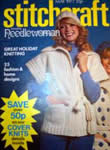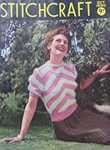This site still under construction - note that many links do not function
For some reason that I cannot fully recall, in March 1976, I purchased
a craft magazine called Stitchcraft. I was in my final year at college,
and my boyfriend had an interest in model aircraft; this probably encouraged
me to buy a magazine one day, while he was pawing over "Practical
Modeller", or some such.
 One thing I can assure you is that even then (or perhaps especially then)
Stitchcraft was definitely not fashionable; I am not sure at which demographic
it was aimed, but it certainly was not people in their early twenties.
Nonetheless, I made quite a few items from it, but these were mainly bazaar
items for charities, kids stuff, and one or two things for my Mother (Violet),
and my Auntie Glad, (I mention their names as I believe that says it all).
One thing I can assure you is that even then (or perhaps especially then)
Stitchcraft was definitely not fashionable; I am not sure at which demographic
it was aimed, but it certainly was not people in their early twenties.
Nonetheless, I made quite a few items from it, but these were mainly bazaar
items for charities, kids stuff, and one or two things for my Mother (Violet),
and my Auntie Glad, (I mention their names as I believe that says it all).
I continued to collect the magazines for over a year. The May 1977 edition (on the right)
finally tipped me over the edge, and I did not buy any more.
 In 2003, I noticed two Stitchcraft magazines in a sale box at a local
quilting exhibition. They were from 1950; I gave them a sentimental glance
and then could not resist buying them.
In 2003, I noticed two Stitchcraft magazines in a sale box at a local
quilting exhibition. They were from 1950; I gave them a sentimental glance
and then could not resist buying them.
In the autumn of 2005, I found Stitchcrafts appearing on eBay, and the
idea formed that I might like to collect some. Again I am not sure when
it fully evolved into the idea of owning all of them. Anyway, I have been actively collecting for only about one year, and the collection is now largely complete.
There are about 600 magazines and it will take me a long time to document them (if indeed I ever complete it) but here it is. If you would like to own any of the things you see, I have a number of duplicates, so it is always worth contacting me to check. Not all of them are in good condition, so their desirability rather depends on whether you are a collector, or whether you want to cherish the content.
Stitchcraft "for the modern woman and her home" - 1930s
The first edition of Stitchcraft was published in October 1932. It was
launched by Paton and Baldwins presumably to market their yarns, and all the materials referenced are their products.
The first three magazines were illustrated with drawings, but by 1933
there were photographs for the covers.
I am not a student of fashion by any means, but it is my impression that
this sort of magazine was fairly mainstream. I know that it was still
quite usual to have clothes made to measure or made up by a seamstress
from commercial patterns. Even so, the magazine surprises me in its adventurous
content ("… a wooden box, which you can inexpensively have made
by a carpenter, or put together yourself"). There seems a lot of
emphasis on making things over, even though at that time the thriftiness
and frugality of the War years were a way off in the future. The magazine
not only included knitting, embroidery (free transfers were in every magazine),
and crafts, but there was a recipe page as well. A fashion page told you
about the latest trends from Paris, and then there was an interpretation
of the style in an included pattern. All aspects of women's domestic interests
in life were covered.
Some people are less enthusiastic about this than I am - see the FullTable for one viewpoint.["Its sole purpose seems to be to keep the women of the period (of a certain class) occupied with something seemly and verging on the artistic."].
Personally, I think this view ignores the fact that women's role was
very limited in any case at this time, and the magazine was providing
avenues for women without much money or their own income to achieve some
of the things they aspired to at the time - although the aspirations may
look modest and the advice patronising by 21st century standards.
Make do and mend - 1940s.
In some ways, although a magazine devoted to home economics was very helpful during the war years, Stitchcraft, along with its readership, had a hard time. It's clear from the adverts (both during and after the war) how hard things were with rationing, and many fibres simply unobtainable and going out of production. Even the magazine itself became half size, printed on really flimsy paper, and some editions covering 2 months at a time. As rationing of one sort or another continued throughout the 1940s (only finally ending in 1952) the war dominated the decade.
You never had it so good - 1950s
It seems to me that Stitchcraft really came into its own in the 1950s, a decade of optimism; however, I wonder even if that is really true. The fifties were not my era so it's hard to judge. I do know that in the 1950s, the ultra-fine synthetic machine-made sweaters were all the rage; hand-knitted items were too bulky - unwanted gifts from your Grandmother. There was the "sloppy Joe" beloved of beatniks (and Audrey Hepburn), and some of the adverts by Patons in the early sixties desperately try to cash in on that to popularise knitting among the young.
Swinging Britain - 1960s
Things seemed to go downhill for Stitchcraft from there. The tone was
relentlessly cheerful, but flying against the full force
of the style revolution in Britain, the articles offered the same "gay oufits",
"pinnies", and bazaar items, which seemed to be from a different
century, not just a different decade.
During this period, there followed various amalgamations with Knitters
Circle, and Needlewoman magazines, as, presumably, they could not sustain
sufficient readerships, despite an emergent interest in ethnic
craft pursuits (spinning, macramé etc) in the seventies.
Back to nature - 1970s
By the 1970s, the magazine most definitely did not hit the spot. A comparable magazine of the time which was fantastically popular and traded on those New Age crafters was "Golden Hands". The so-called part work started in the seventies and built up into a 2 year collection, (this was while I was still at school and could not afford to buy it). However, a few years later on, I bought the less well-known "Golden Hands Monthly" magazine. You only have to look at Golden Hands (if you can view it objectively without laughing) to see how fresh and modern it looked in comparison with Stitchcraft.
New Wave - 1980s
By the 1980s it was all over, and Patons finally decided to cease publication in favour of offering Stitchcraft books and pamphlets (for example, "Knitting from the Isles" and so on), which they had offered before ("Twin Sets", "Sock and Stockings") alongside the monthly edition. The irony is that just at this time Rowan started up and a whole new decade of knitting enthusiasm was born, but I do not think dear old Stitchcraft could have reinvented itself to match the new style.